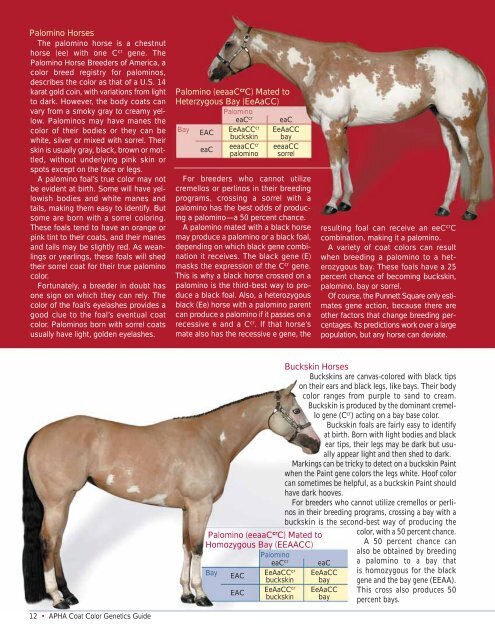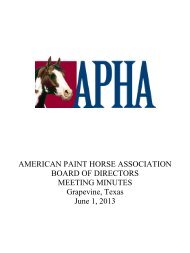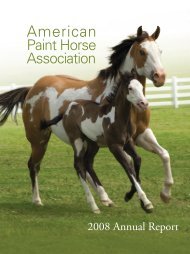Coat Color Genetics - Press - American Paint Horse Association
Coat Color Genetics - Press - American Paint Horse Association
Coat Color Genetics - Press - American Paint Horse Association
You also want an ePaper? Increase the reach of your titles
YUMPU automatically turns print PDFs into web optimized ePapers that Google loves.
The palomino horse is a chestnut<br />
horse (ee) with one Ccr Palomino <strong>Horse</strong>s<br />
gene. The<br />
Palomino <strong>Horse</strong> Breeders of America, a<br />
color breed registry for palominos,<br />
describes the color as that of a U.S. 14<br />
karat gold coin, with variations from light<br />
to dark. However, the body coats can<br />
vary from a smoky gray to creamy yellow.<br />
Palominos may have manes the<br />
color of their bodies or they can be<br />
white, silver or mixed with sorrel. Their<br />
skin is usually gray, black, brown or mottled,<br />
without underlying pink skin or<br />
spots except on the face or legs.<br />
A palomino foal’s true color may not<br />
be evident at birth. Some will have yellowish<br />
bodies and white manes and<br />
tails, making them easy to identify. But<br />
some are born with a sorrel coloring.<br />
These foals tend to have an orange or<br />
pink tint to their coats, and their manes<br />
and tails may be slightly red. As weanlings<br />
or yearlings, these foals will shed<br />
their sorrel coat for their true palomino<br />
color.<br />
Fortunately, a breeder in doubt has<br />
one sign on which they can rely. The<br />
color of the foal’s eyelashes provides a<br />
good clue to the foal’s eventual coat<br />
color. Palominos born with sorrel coats<br />
usually have light, golden eyelashes.<br />
12 • APHA <strong>Coat</strong> <strong>Color</strong> <strong>Genetics</strong> Guide<br />
Palomino (eeaaCcrC) Mated to<br />
Heterzygous Bay (EeAaCC)<br />
Palomino<br />
eaCcr eaC<br />
EAC<br />
EeAaCCcr buckskin<br />
EeAaCC<br />
bay<br />
eaC<br />
eeaaCCcr Bay<br />
palomino<br />
eeaaCC<br />
sorrel<br />
For breeders who cannot utilize<br />
cremellos or perlinos in their breeding<br />
programs, crossing a sorrel with a<br />
palomino has the best odds of producing<br />
a palomino—a 50 percent chance.<br />
A palomino mated with a black horse<br />
may produce a palomino or a black foal,<br />
depending on which black gene combination<br />
it receives. The black gene (E)<br />
masks the expression of the C cr gene.<br />
This is why a black horse crossed on a<br />
palomino is the third-best way to produce<br />
a black foal. Also, a heterozygous<br />
black (Ee) horse with a palomino parent<br />
can produce a palomino if it passes on a<br />
recessive e and a C cr . If that horse’s<br />
mate also has the recessive e gene, the<br />
Palomino (eeaaCcrC) Mated to<br />
Homozygous Bay (EEAACC)<br />
Palomino<br />
eaCcr eaC<br />
EAC<br />
EeAaCCcr buckskin<br />
EeAaCC<br />
bay<br />
EAC<br />
EeAaCCcr Bay<br />
buckskin<br />
EeAaCC<br />
bay<br />
resulting foal can receive an eeC cr C<br />
combination, making it a palomino.<br />
A variety of coat colors can result<br />
when breeding a palomino to a heterozygous<br />
bay. These foals have a 25<br />
percent chance of becoming buckskin,<br />
palomino, bay or sorrel.<br />
Of course, the Punnett Square only estimates<br />
gene action, because there are<br />
other factors that change breeding percentages.<br />
Its predictions work over a large<br />
population, but any horse can deviate.<br />
Buckskin <strong>Horse</strong>s<br />
Buckskins are canvas-colored with black tips<br />
on their ears and black legs, like bays. Their body<br />
color ranges from purple to sand to cream.<br />
Buckskin is produced by the dominant cremello<br />
gene (C cr ) acting on a bay base color.<br />
Buckskin foals are fairly easy to identify<br />
at birth. Born with light bodies and black<br />
ear tips, their legs may be dark but usually<br />
appear light and then shed to dark.<br />
Markings can be tricky to detect on a buckskin <strong>Paint</strong><br />
when the <strong>Paint</strong> gene colors the legs white. Hoof color<br />
can sometimes be helpful, as a buckskin <strong>Paint</strong> should<br />
have dark hooves.<br />
For breeders who cannot utilize cremellos or perlinos<br />
in their breeding programs, crossing a bay with a<br />
buckskin is the second-best way of producing the<br />
color, with a 50 percent chance.<br />
A 50 percent chance can<br />
also be obtained by breeding<br />
a palomino to a bay that<br />
is homozygous for the black<br />
gene and the bay gene (EEAA).<br />
This cross also produces 50<br />
percent bays.




